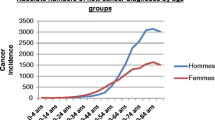Abstract
Purpose The number of cancer survivors is rapidly growing due to improved treatment and ageing population. Almost half of cancer patients will experience a cancer diagnosis during working age when career and work-related issues play an important role. Many cancer survivors are at risk for unemployment which greatly affects their quality of life and financial situation. Research on cancer and work is therefore of great importance but scattered over Europe and lacking appropriate dissemination. Moreover, interventions supporting employment of cancer survivors are urgently required but scarcely developed. Methods The European Cancer and Work Network (CANWON) aims to combine knowledge on: (1) prognostic factors of unemployment in cancer survivors including gender- and country-specific differences; (2) work-related costs of survivorship for both patients and society; (3) the role of employers; and (4) development and evaluation of innovative, interdisciplinary interventions which effectively support employment. Furthermore, it aims at disseminating research knowledge and best practice worldwide. Results CANWON currently unites 23 teams from 15 countries across different stakeholders and research areas. The expected benefits are rapid exchange of research knowledge, standardised methods and techniques, innovative interventions, future guidelines on cancer and work and the improvement of quality of life of cancer patients. Conclusions Understanding prognostic factors, work-related costs, role of the employer and innovative interventions in relation to work in cancer survivors might progress the understanding of other patients with long-term conditions therefore the knowledge resulting from CANWON will benefit a wide range of patient groups.
Similar content being viewed by others
References
Estimated US cancer prevalence counts: who are our cancer survivors in the US? http://dccps.nci.nih.gov/ocs/prevalence/ (2012). Accessed 27 June 2013.
Ferlay J, Autier P, Boniol M, Heanue M, Colombet M, Boyle P. Estimates of the cancer incidence and mortality in Europe in 2006. Ann Oncol. 2007;18:581–92.
La Vecchia C, Bosetti C, Lucchini F, Bertuccio P, Negri E, Boyle P, Levi F. Cancer mortality in Europe, 2000–2004, and an overview of trends since 1975. Ann Oncol. 2010;21:1323–60.
Harrington CB, Hansen JA, Moskowitz M, Todd BL, Feuerstein M. It’s not over when it’s over: long-term symptoms in cancer survivors—a systematic review. Int J Psychiatry Med. 2010;40:163–81.
Mehnert A. Employment and work-related issues in cancer survivors. Crit Rev Oncol Hematol. 2011;77:109–30.
de Boer AG, Taskila T, Ojajärvi A, van Dijk FJ, Verbeek JH. Cancer survivors and unemployment: a meta-analysis and meta-regression. JAMA. 2009;301:753–62.
Taskila T, Lindbohm ML. Factors affecting cancer survivors’ employment and work ability. Acta Oncol. 2007;46:446–51.
Roelen CA, Koopmans PC, Groothoff JW, van der Klink JJ, Bültmann U. Return to work after cancer diagnosed 2002, 2005, and 2008. J Occup Rehabil. 2011;21:335–41.
Amir Z, Neary D, Luker K. Cancer survivors’ views of work 3 years post diagnosis: a UK perspective. Eur J Oncol Nurs. 2008;12:190–7.
Spelten ER, Sprangers MA, Verbeek JH. Factors reported to influence the return-to-work of cancer survivors: a literature review. Psychooncology. 2002;11:124–31.
Tamminga SJ, de Boer AG, Verbeek JH, Frings-Dresen MH. Breast cancer survivors’ views of factors that influence the return-to-work process—a qualitative study. Scand J Work Environ Health. 2012;38:144–54.
Paraponaris A, Teyssier LS, Ventelou B. Job tenure and self-reported workplace discrimination for cancer survivors 2 years after diagnosis: does employment legislation matter? Health Policy. 2010;98:144–55.
Sharp L, Timmons A. Social welfare and legal constraints associated with work among breast and prostate cancer survivors: experiences from Ireland. J Cancer Surviv. 2011;5:382–94.
Cost http://www.cost.eu/. Accessed 28 June 2013.
EU Labour Force Study ad hoc module on employment of disabled people. LFS, 2002.
Jans LH, Kaye HS, Jones EC. Getting hired: successfully employed people with disabilities offer advice on disclosure, interviewing, and job search. J Occup Rehabil. 2012;22:155–65.
Burstrom B, Holland P, Lindholm C. Winners and losers in flexible labor markets: the fate of women with chronic illness in contrasting policy environments—Sweden and Britain. Int J Health Serv. 2003;33:199–217.
Acknowledgments
The CANWON network is funded by COST (IS1211) http://www.cost.eu/domains_actions/isch/Actions/IS1211.
Author information
Authors and Affiliations
Corresponding author
Additional information
This study was carried out on behalf of CANWON members. Details given in Table 2.
Rights and permissions
About this article
Cite this article
de Boer, A.G.E.M. The European Cancer and Work Network: CANWON. J Occup Rehabil 24, 393–398 (2014). https://doi.org/10.1007/s10926-013-9474-5
Published:
Issue Date:
DOI: https://doi.org/10.1007/s10926-013-9474-5




